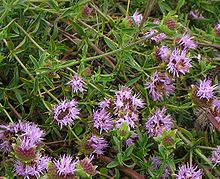- Monardella odoratissima
-
Monardella odoratissima Scientific classification Kingdom: Plantae (unranked): Angiosperms (unranked): Eudicots (unranked): Asterids Order: Lamiales Family: Lamiaceae Genus: Monardella Species: M. odoratissima Binomial name Monardella odoratissima
Benth.Monardella odoratissima (Mountain Coyote Mint, Mountain Beebalm, or Mountain Pennyroyal) is a perennial flowering plant which grows in mountain forests and sagebrush scrub. It is a member of the Lamiaceae, or mint family. It has the minty odor characteristic of this family.
Contents
Distribution
Monardella odoratissima is found in montane forests above 600 m. and below 3100 m.[1] It is found in many Northern California mountain ranges, including the Klamath Mountains and the North California Coast Ranges, the Cascade Range, the Sierra Nevada, the Modoc Plateau, White Mountains and Inyo Mountains. It is found outside California, as far north as Washington, and in Nevada[1] and Utah[2].
Description
Monardella odoratissima is an upright to sprawling perennial herb which can be woody at the base. It ranges from 30 centimeters to one meter-3 feet in height and equally wide. The plant can be either a smooth dark green or a hairy dark grey-green, with many gradations in between. It is often dotted with glands which release a strongly minty odor when the plant is touched.
The leaves can lance-shaped to ovate, and are smooth-edged. They measure up to 4.5 centimeters long.[1]
The flowers range in color from white and pale pink to light bluish-purple. The inflorescence is a head, which can be from 10 mm. to 25 mm. wide, with outer bracts which are like leaves, and inside bracts which enclose the many flowers like a cup. These bracts can be hairy or smooth, and sometimes have a rose or purplish color. The calyx, which is inside these bracts, is hairy and has 5 lobes. The corolla is tubular and has two lips. The upper lip is erect and has two lobes, but the lower lip curves downward and has 3 lobes. It has 4 stamens, and a style which has two unequal lobes.
The fruits, like most of fruits of the mint family, are 4 smooth nutlets which are dark brown to black in color.
Cultivation
Monardella odoratissima is easy to grow as a Garden plant. Although the Monardellas are in the mint family, most Monardellas do not grow from runners. However, they can still be propagated easily from cuttings.
They are very attractive to butterflies, which are their main pollinator.
Monardella odoratissima will grow in full sun to medium shade. It can be pruned lightly in the late fall or early winter to create a bushier plant, as they can otherwise be sprawling. They bloom profusely anytime from April through August. Because they are floriferous, they look best when spent blooms are deadheaded. [3]
References
- ^ a b c Jokerst, James D. ; Jepson Manual treatment for Monardella odoratissima. Jepson Flora Project Interchange, Regents of the University of California. (Online)
- ^ Welsh, Stanley (1993). A Utah Flora. Provo, UT: Brigham Young University. pp. 374. ISBN 0-8425-2313-8.
- ^ Bornstein, Fross, and O'Brien, 2005. California Native Plants for the Garden. Cachuma Press
- Abrams, Leroy; 1951. Illustrated flora of the Pacific States, Stanford University Press
External links
- Jepsn Manual Treatment - Monardella odoratissima
- USDA PLANTS Database - Monardella odoratissima
- Monardella odoratissima - Photo gallery
Categories:- Monardella
- Flora of Oregon
- Flora of Nevada
- Flora of Washington (state)
- Flora of California chaparral and woodlands
- Flora of the Sierra Nevada region (U.S.)
- Flora of the California desert regions
- Garden plants of North America
- Drought-tolerant plants
- Groundcovers
- Butterfly food plants
- Lamiaceae stubs
Wikimedia Foundation. 2010.

